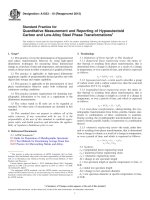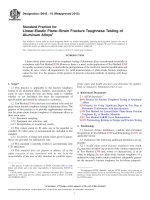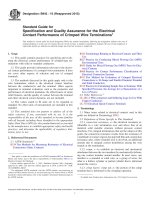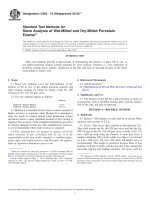Astm e 1038 10 (2015)
Bạn đang xem bản rút gọn của tài liệu. Xem và tải ngay bản đầy đủ của tài liệu tại đây (85.34 KB, 4 trang )
Designation: E1038 − 10 (Reapproved 2015)
Standard Test Method for
Determining Resistance of Photovoltaic Modules to Hail by
Impact with Propelled Ice Balls1
This standard is issued under the fixed designation E1038; the number immediately following the designation indicates the year of
original adoption or, in the case of revision, the year of last revision. A number in parentheses indicates the year of last reapproval. A
superscript epsilon (´) indicates an editorial change since the last revision or reapproval.
2. Referenced Documents
1. Scope
2.1 ASTM Standards:2
E772 Terminology of Solar Energy Conversion
E822 Practice for Determining Resistance of Solar Collector
Covers to Hail by Impact With Propelled Ice Balls
E1036 Test Methods for Electrical Performance of Nonconcentrator Terrestrial Photovoltaic Modules and Arrays
Using Reference Cells
E1462 Test Methods for Insulation Integrity and Ground
Path Continuity of Photovoltaic Modules
1.1 This test method provides a procedure for determining
the ability of photovoltaic modules to withstand impact forces
of falling hail. Propelled ice balls are used to simulate falling
hailstones.
1.2 This test method defines test specimens and methods for
mounting specimens, specifies impact locations on each test
specimen, provides an equation for determining the velocity of
any size ice ball, provides a method for impacting the test
specimens with ice balls, provides a method for determining
changes in electrical performance, and specifies parameters
that must be recorded and reported.
3. Terminology
3.1 Definitions—For definitions of terms used in this test
method, see Terminology E772.
3.2 Symbols—The following symbols are used in this test
method.
m = ice ball mass, g,
d = ice ball diameter, mm, and
r = ice ball radius, mm.
3.2.1 Speed:
Vt = ice ball terminal, m s−1,
Vw = wind, m s−1, and
Vr = ice ball resultant, m s−1.
1.3 This test method does not establish pass or fail levels.
The determination of acceptable or unacceptable levels of ice
ball impact resistance is beyond the scope of this test method.
1.4 The size of the ice ball to be used in conducting this test
is not specified. This test method can be used with various sizes
of ice balls.
1.5 This test method may be applied to concentrator and
nonconcentrator modules.
1.6 The values stated in SI units are to be regarded as
standard. No other units of measurement are included in this
standard.
1.7 This standard does not purport to address all of the
safety problems, if any, associated with its use. It is the
responsibility of the user of this standard to establish appropriate safety and health practices and determine the applicability of regulatory limitations prior to use. For specific
precautionary statements, refer to 5.1, Section 6, Note 8, and
Note 9.
4. Significance and Use
4.1 In many geographic areas, there is concern about the
effect of falling hail upon photovoltaic modules. This test
method may be used to determine the ability of photovoltaic
modules to withstand the impact forces of hailstones. In this
test method, the ability of a photovoltaic module to withstand
hail impact is related to its tested ability to withstand impact
from ice balls. The effects of impact may be either physical or
electrical degradation of the module.
1
This test method is under the jurisdiction of ASTM Committee E44 on Solar,
Geothermal and Other Alternative Energy Sources and is the direct responsibility of
Subcommittee E44.09 on Photovoltaic Electric Power Conversion.
Current edition approved March 1, 2015. Published April 2015. Originally
approved in 1985. Last previous edition approved in 2010 as E1038 – 10. DOI:
10.1520/E1038-10R15.
2
For referenced ASTM standards, visit the ASTM website, www.astm.org, or
contact ASTM Customer Service at service @astm.org. For Annual Book of ASTM
Standardsvolume information, refer to the standard’s Document Summary page on
the ASTM website.
Copyright © ASTM International, 100 Barr Harbor Drive, PO Box C700, West Conshohocken, PA 19428-2959. United States
1
E1038 − 10 (2015)
repeatable conditions for before and after tests are required for
determining electrical changes.
4.3.2 A range of observable effects may be produced by
impacting various types of photovoltaic modules. Physical
effects on modules may vary from no effect to penetration by
the ice ball. Some physical changes in the module may be
visible when there is no apparent electrical degradation of the
module.
4.3.3 Electrical changes may vary from no effect to no
output. All effects of the impacts must be described in the
report so that an estimate of their significance can be made.
4.2 This test method describes a standard procedure for
mounting the test specimen, conducting the impact test, and
reporting the effects.
4.2.1 The procedures for mounting the test specimen are
provided to assure that modules are tested in a configuration
that relates to their use in a photovoltaic array.
4.2.2 Six or more impact locations are chosen to represent
vulnerable sites on modules and general locations are listed in
Table 1. Only a single impact is specified at each of the impact
locations.
4.2.3 Resultant speed is used to simulate the speed that may
be reached by hail accompanied by wind. The resultant speed
used in this test method is determined by vector addition of
horizontal wind velocity plus vertical ice ball terminal velocity.
4.2.4 Ice balls are used in this test method to simulate
hailstones. Hailstones are variable in properties such as shape,
density, and frangibility (for fracture characteristics, see Ref
(10) in Practice E822). These properties affect factors such as
the duration and magnitude of the impulsive force acting on the
module and the area over which the impulse is distributed. Ice
balls (with a density, frangibility, and terminal velocity near the
range of hailstones) are the nearest hailstone approximation
known at this time. Ice balls generally are harder and denser
than hailstones; therefore, an ice ball simulates the worst case
hailstone. Perhaps the major difference between ice balls and
hailstones is that hailstones are more variable than ice balls. Ice
balls can be uniformly and repeatedly manufactured to assure
a projectile with known properties.
4.2.5 Ice balls are directed normal to the surface of a test
specimen, which transfers the greatest kinetic energy to the test
specimen, unlike a non-normal impact at a glancing angle.
4.4 This test method does not specify the size or velocity of
ice balls or maximum number of impacts to be used in making
the test. These determinations will be based on frequency and
severity of expected hail occurrences and the intent of the
testing.
4.4.1 If the testing is being performed to evaluate impact
resistance of a single module, or several modules, it may be
desirable to repeat the test using several sizes and velocities of
ice balls. In this manner, the different effects of various sizes
and velocities of ice balls may be determined. However, no
point shall be impacted more than once (see 7.10).
4.4.2 The size and frequency of hail varies significantly
among various geographic areas. If testing is being performed
to evaluate modules intended for use in a specific geographic
area, the ice ball size should correspond to the level of hail
impact resistance required for that area. Information on hail
size and frequency can be found in Appendix X1 of Practice
E822 and footnotes 3 and 4 of this test method, or may be
available from local historical weather records.
4.4.3 When testing modules that are designed to be in a
stowed position during hail storms, additional impact locations
should be chosen accordingly.
4.3 Data generated using this test method may be used for
the following: (1) to evaluate impact resistance of a module,
(2) to compare the impact resistance of several modules, (3) to
provide a common basis for selection of modules for use in
various geographic areas, or (4) to evaluate changes in impact
resistance of modules due to other environmental factors, such
as weathering.
4.3.1 This test method requires analysis of visual effects, as
well as electrical measurements. Visual effects are generally
more sensitive than the electrical measurements; therefore, the
absolute values for voltage and current are not critical, but
4.5 The hail impact resistance of modules may change as
the materials are exposed to various environmental factors.
This test method may be used to evaluate degradation by
comparison of hail impact resistance data measured before and
after exposure to other such environmental factors.
5. Apparatus
5.1 Launcher, capable of propelling a selected ice ball at the
specified speed within 65 %. The aiming accuracy of the
launcher must be sufficient for the ice ball to strike the
specified impact area, or the surrounding area must be masked
for protection from inadvertent impacts.
TABLE 1 Candidate Locations and Suggested Order for Impact
Points
Location number
Description
1
2
Centers of cells
Edges of cells, especially near electrical
contacts
Points of minimum spacing between cells
Points of maximum distance from points of
support in 6
Corners and edges of the module
Points of support for any superstrate material
Back of module, if exposed in stowed
orientation
Electrical terminals and leads
Centers of lenses approximately 50 mm from
lens support points
3
4
5
6
7
8
NOTE 1—Launchers that have proven suitable utilize a compressed air
supply, an accumulator tank, a large diameter quick-opening valve, and
interchangeable barrels to accommodate different sizes of ice balls3,4 (see
Ref (14) of Practice E822). Another launcher that has been used is a
table-mounted slingshot with an adjustable hand rest.
3
Moore, D., and Wilson, A., “Photovoltaic Solar Panel Resistance to Simulated
Hail,” Low-Cost Solar Array Project Report 5101-62, Jet Propulsion Laboratory,
Pasadena, CA, 1978. Available from National Technical Information Service, 5285
Port Royal Road, Springfield, VA 22161-0001.
4
Jenkins, D. R., and Mathey, R. G., “Hail Impact Testing Procedure for Solar
Covers,” NBSIR 82-2487, National Bureau of Standards, April 1982. Available
from National Technical Information Service, 5285 Port Royal Road, Springfield,
VA 22161-0001.
9
2
E1038 − 10 (2015)
5.2 Speed Meter, for measuring ice ball speed to within
62 %.
NOTE 4—Considerations for appropriate wind speeds may be found in
footnote 4.
5.3 Test Base—A rigid mount for supporting the test module
in a fashion that simulates actual mounting applications.
7.4 Electrical Tests:
7.4.1 Perform an insulation current leakage test on the test
module according to 7.1 of Test Methods E1462.
7.4.2 Measure the open-circuit voltage and short-circuit
current of the module. As acceptable procedure is given in
Methods E1036.
5.4 Molds, for casting spherical ice balls of appropriate
diameter.
NOTE 2—Molds made from silicone rubber or expanded polystyrene
have been found suitable.
NOTE 5—Because damage to a module that results from ice ball impact
is usually catastrophic, it is only necessary to determine if the Voc and Isc
survive the impact test. Thus, a simple measurement of Voc and Isc using
a voltmeter and an ammeter while the module is illuminated is permissible.
5.5 Freezer, for making ice balls in the molds, controlled
at − 10 6 5°C.
5.6 Storage Container—An ice chest or an ice water/salt
mixture and a bag for the ice balls capable of maintaining
temperature of − 4 6 2°C.
7.5 Select a minimum of six target impact points identified
in Table 1.
5.7 Balance, for determining ice ball mass to within 6 1 %.
7.6 Document visual features in the impact areas that may
be affected by the ice balls. Photographs may be used.
5.8 Ring Gages or Equivalent, for determining ice ball size.
7.7 Mount the test module on a suitable test base to simulate
an actual installation of the module. The specified impact
points shall not be obstructed by the mounting fixtures.
6. Hazards
6.1 The operation of the equipment described in Section 5
may expose personnel to risk of injury from propelled or
rebounded ice balls, fragments of the broken test specimen, and
from the noise that may develop. Eye and ear protection shall
be considered as minimum protection for the operator.
7.8 The test module temperature shall be stable and the
ambient temperature shall be 20 6 10°C.
7.9 Position the module to assure that the path of the
propelled ice ball at impact will be perpendicular (90 6 5°) to
the surface at the target point.
7. Procedure
7.1 Determine the ice ball size to be used in the test.
NOTE 6—The apparatus may be designed so that the path of the ice ball
is at any angle, for example, horizontal or vertical, as long as the other
requirements of the test are met.
NOTE 3—The size of the ice balls shall be specified in 10-mm
increments by the sponsor of the test or the test director.
d, mm
15
25
35
45
55
65
75
85
m = 0.00385 r 3.
m, g
1.6
7.5
20.6
43.9
80.1
132.2
203
296
7.10 Aim the launcher at a target impact point that has not
previously been impacted. Each point shall be impacted one
time only.
7.11 Position the speed meter such that the ice ball speed
will be measured between the launcher and the test specimen.
The ice ball should exit the speed meter not more than 1.0 m
in front of the impact location. Prepare the speed meter for the
test.
7.2 Using the ice mold(s), make sufficient quantities of ice
balls of the prescribed size(s). Examine for cracks, size, and
weight. An acceptable ball shall meet the following criteria:
7.2.1 Cracks—No cracks visible to the unaided eye.
7.2.2 Size—Within 65 % of specified diameter, and
7.2.3 Mass—Within 65 % of nominal value listed.
NOTE 7—Testing of the apparatus may be done by impacting ice balls
on a simulated target placed in front of the module.
NOTE 8—A shield may be placed around the impact point for protection.
7.12 Set the launcher controls to assure that the ball will be
propelled at the speed determined in 7.3.
7.3 Calculate the resultant speed corresponding to the ice
ball diameter and selected wind speed using the following
equations:
Vr 5
=V
2
t
1V
2
w
7.13 Remove an ice ball from the storage container.
7.14 Place the ice ball in the launcher.
7.15 Launch the ice ball. Measure and record the speed of
the ice ball. Ice balls shall impact the test specimen within 60
s of removal from the storage container.
(1)
where:
V t 5 4.44 =d
NOTE 9—Caution: Personnel protective equipment may be required
during this step (see 6.1).
(2)
7.3.1 The wind speed is selected from the following table by
the sponsor of the test or the test director.
7.16 Mark the ice ball impact location.
7.17 Record all visual effects of the impact.
m·s -1
0
15
20
30
7.18 Repeat 7.8 – 7.16, until one of the following occurs:
7.18.1 All selected target points have been impacted, or
7.18.2 Severe damage of the module occurs.
3
E1038 − 10 (2015)
8.1.7 Size, mass, and speed of ice balls used,
8.1.8 Temperature of module during impacts,
8.1.9 Description of the launcher and the speed meter, and
8.1.10 Any deviation from this test method.
7.19 At the completion of the test, repeat the electrical tests
in 7.4.
8. Report
8.1 Report, as a minimum, the following information:
8.1.1 Module manufacturer and type,
8.1.2 Module description that includes the following items:
8.1.2.1 Major dimensions,
8.1.2.2 Substrate material and thickness,
8.1.2.3 Superstrate material and thickness, and
8.1.2.4 Cell material,
8.1.3 A line drawing or photograph of the module with
impact sites marked,
8.1.4 A line drawing or photograph of the module mounting,
8.1.5 Description of visual effects of ice ball impacts, if any,
8.1.6 Changes between pre and post electrical test results, if
any,
9. Precision and Bias
9.1 The ice-ball impact testing described in this test method
does not produce numeric results that would be subject to
ASTM procedures for evaluating the precision and bias of this
test method. However, the precision and bias of the electrical
performance measurements, when performed in accordance
with Methods E1036, are subject to the provisions of that
document.
10. Keywords
10.1 hail resistance; ice ball impact testing; modules; photovoltaics; solar energy
ASTM International takes no position respecting the validity of any patent rights asserted in connection with any item mentioned
in this standard. Users of this standard are expressly advised that determination of the validity of any such patent rights, and the risk
of infringement of such rights, are entirely their own responsibility.
This standard is subject to revision at any time by the responsible technical committee and must be reviewed every five years and
if not revised, either reapproved or withdrawn. Your comments are invited either for revision of this standard or for additional standards
and should be addressed to ASTM International Headquarters. Your comments will receive careful consideration at a meeting of the
responsible technical committee, which you may attend. If you feel that your comments have not received a fair hearing you should
make your views known to the ASTM Committee on Standards, at the address shown below.
This standard is copyrighted by ASTM International, 100 Barr Harbor Drive, PO Box C700, West Conshohocken, PA 19428-2959,
United States. Individual reprints (single or multiple copies) of this standard may be obtained by contacting ASTM at the above
address or at 610-832-9585 (phone), 610-832-9555 (fax), or (e-mail); or through the ASTM website
(www.astm.org). Permission rights to photocopy the standard may also be secured from the Copyright Clearance Center, 222
Rosewood Drive, Danvers, MA 01923, Tel: (978) 646-2600; />
4









